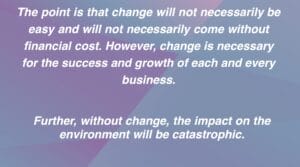The reduction of GHG and the need to move to a more sustainable way of living are issues which impact us all both on a personal and business level. To bring about meaningful change and substantially reduce our carbon emissions within the timescales set by our government, we all need to take steps which will have a long-term impact on environmental, social and governance (ESG) issues globally. Whilst the commercial returns from such issues may be questionable to a business in 2024, the need to focus upon the values espoused by ESG for both the sustainability of a business and the environment is compelling. Not only will such focus provide a more sustainable future for us all, but it will forge a way forward for businesses to comply with their future obligations which lie just around the corner.
Over the coming months and years, requirements on companies to be more sustainable will increase. Those which are at the forefront of this march will undoubtedly benefit from the head start, making themselves more appealing to investors, customers and other key stakeholders who have an eye on the future of our planet.
The principle of a circular economy has already gained traction, with many companies looking to operate in a way which minimizes waste and pollution and is now opening up new markets and revenue streams. It is becoming apparent that investors are latching onto this principle when looking at potential investments and, being ahead of the game on this front, may ultimately lead to a more profitable and sustainable business in all senses.
 BlackRock, the world’s largest asset manager, is a participant in the United Nations Global Compact and is a strong advocate of ESG. This massive organisation manages more than $800 billion via its sustainable investing platform and uses financially material ESG data as part of its investment processes. It has posted net ESG inflows every quarter for the past two years.
BlackRock, the world’s largest asset manager, is a participant in the United Nations Global Compact and is a strong advocate of ESG. This massive organisation manages more than $800 billion via its sustainable investing platform and uses financially material ESG data as part of its investment processes. It has posted net ESG inflows every quarter for the past two years.
This ESG fund market is not simply related to EV, clean energy and agroforestry businesses but encompasses the sustainable behaviours of tech giants such as Microsoft and Apple. BlackRock’s chief executive, Larry Fink, has been a very vocal supporter of the ESG movement, urging the boards of their investee businesses to integrate sustainability into their strategies. However, in his most recent open letter published on the BlackRock web site, he declined to use the term ESG for the first time in a few years.
The battle over the term and the investment practice to which it refers has become increasingly weaponised by both those on the left and right of politics in the US. Whilst ESG issues have to a degree been marked as toxic in the run up to the US election at the end of 2024, despite this, there is no doubt that this trend in provision of ESG data will be key for businesses going forward.
So, for thousands of UK businesses the question is,

The answer to this is not simple but is worth bottoming out at the earliest possible stage. In the long-term, avoidance is not going to be an option and the sooner a company starts to understand and evaluate the need to decarbonise operations and products operating within the guidelines of the GHG Protocol, the easier the transition will be.
 Reporting requirements under the GHG Protocol
Reporting requirements under the GHG Protocol
Under the GHG Protocol, companies have various reporting obligations divided into Scope 1, Scope 2 and Scope 3 emissions.
These scopes can be broken down as follows:
Scope 1: Covers the GHG emissions a company makes directly e.g., while running its typically gas driven boilers or the company vehicles. This means that the company is directly involved in the action which releases the GHG. Companies will normally have the source data needed to convert direct purchases into a value in tonnes of GHG, often referred to as CO2e, CO2 equivalent.
These Scope 1 emissions can be broken down into 4 categories:
- Stationary combustion – this includes emissions that come from combustion of fossil fuels eg from boilers that provide heat to buildings or other industrial applications. The most common fuels within this area are natural gas, liquified petroleum gas, oil and propane.
- Mobile combustion – this includes emissions from burning of fuel of all vehicles that are owned or leased by an organisation. To be noted, EVs and plug-in hybrids will fall within Scope 2 – indirect emissions.
- Fugitive emissions – these are unintentional releases/leaks of GHG eg refrigerant gases or gases from air-conditioning units. These F-gases fall under an EU F-gas regulation. The global warming potential of these F-gases can be hugely impactful and therefore recording of these is encouraged to raise awareness.
- Process emissions – these are released during industrial processes and on-site manufacturing eg the processing or manufacturing of chemicals or the CO2 emissions produced during a manufacturing process.
 Businesses are engaging in assessing their Scope 1 emissions.
Businesses are engaging in assessing their Scope 1 emissions.
For example, in 2021, Octopus focused on measuring its emissions across its subsidiary companies and in 2022, reduced its total emissions by 20% from the baseline achieved in 2021. Octopus also set an interim target for 2025 for Scope 1, 2 and 3, launched an internal campaign to encourage employees to make more sustainable choices and reduced business travel emissions by putting an internal carbon budget in place.
Octopus has also invested a sizeable sum of money in Deep Green, a company harnessing the heat created by data centres to heat local authority swimming pools. According to a Deep Green spokesperson, if 1% of the UK’s data centres processing demand was harnessed by Deep Green, the company could heat every pool in the country continuously. This would be hugely impactful in the drive towards a cleaner, cheaper energy future. In return, the swimming pool cold water can cool the servers running the data centre – a great example of solving two sustainability problems and evidence of the circular economy in action.
Companies managing fleets of vehicles have come up with logistical ways to improve carbon emissions. There are thought to be 6 actions which can reduce fleet costs and increase fleet efficiency:
(1) Monitor driver behaviour (needless idling and inappropriate gear shifting contribute to fuel loss);
(2) Optimise route planning;
(3) Practise predictive tyre management (slow leaks and improper tyre pressure result in 2.5% increase in fuel use);
(4) Schedule in preventative maintenance (properly maintained vehicles last longer and run better/more efficiently);
(5) Implement fuel-efficient driving practices (drivers are one of the biggest fuel economy influencers and by empowering them to improve performance with information fed to them via in-vehicle navigation devices, consumption can be improved, providing a more fuel-efficient and safer fleet);
(6) Recharge EVs more cheaply and install on premise charging facilities (prices across public rapid charging networks vary considerably and 3rd-party apps can help direct drivers away from expensive charging options).
A southeast based temporary power provider was challenged by some of its biggest corporate clients to “change our environmental behaviour” and turned to the consultancy market for support.
Whilst the company began the process of negotiating with the manufacturers of its products so they could transition their assets from diesel powered to HVO and battery driven ones, they had limited control over the time and cost of this process.
They could, however, explore decarbonisation of their transport fleet of some 150 vehicles. As these included everything from company cars to light goods vehicles (LGVs) and off road 4×4 trucks to heavy goods vehicles (HGVs), the solutions were diverse.
Where possible the company is now replacing company cars with EV options and has introduced a salary sacrifice scheme to enable employees to invest in electric vehicles (just to complicate things, employee commuting falls under Scope 3) whilst newer LGVs are now either battery powered or fuelled by hydrotreated, or hydrogenated, vegetable fuel oil (HVO).
 However, vehicles are still (for the moment) driven by human beings and a huge investment in driver training is paying dividends, using guidance from the Fleet Operating Recognition Scheme. An in-cab traffic light based system tells the driver whether they are optimising fuel consumption and minimising carbon emissions and this has led to informal competition between drivers to record the best monthly performance.
However, vehicles are still (for the moment) driven by human beings and a huge investment in driver training is paying dividends, using guidance from the Fleet Operating Recognition Scheme. An in-cab traffic light based system tells the driver whether they are optimising fuel consumption and minimising carbon emissions and this has led to informal competition between drivers to record the best monthly performance.
Whilst still looking at the vehicle market, improbable though it may sound, electric HGVs are also starting to gain market share in the UK logistics market. Earlier this year, DHL Supply Chain replaced a number of diesel vehicles with 4 Volvo FM electric heavy duty tractor units which come with a range of up to 300km/180 miles. This allows them to complete full round-trips servicing DHL’s retail and automotive customers across the UK.
The CEO of DHL Supply Chain stated that use of these vehicles represented an “important milestone” in its journey to reducing emissions and that they are proud to be leading the way in use of EVs for commercial purposes.
Scope 2: These are emissions a company makes indirectly eg when the electricity the company buys for heating/cooling its offices is being produced on its behalf. It is possible to keep this figure low by, for example, transitioning to electric vehicles.
For companies with manufacturing operations and/or multiple locations and retail outlets, Scope 2 emissions will make up a very large part of their overall carbon footprint because most companies get their energy from public utilities instead of generating their own and utilities often still generate their energy from sources that burn fossil fuel. Companies can reduce such Scope 2 emissions by procuring specific supplies of energy which can be attributed by reliable Renewable Energy Certificates and Guarantees of Origin and investing in their own sources of renewable energy such as solar PV, small unit wind turbines and ground/air source heat pumps.
 Kent based business Alpha 311 has a possible solution to the challenges of the wind power market, namely the size and location of giant turbines. Their vertical axis wind turbine is small in size and generates power on a local basis. As the company states, every road, bridge, building or tower can become a wind turbine.
Kent based business Alpha 311 has a possible solution to the challenges of the wind power market, namely the size and location of giant turbines. Their vertical axis wind turbine is small in size and generates power on a local basis. As the company states, every road, bridge, building or tower can become a wind turbine.
Alpha 311 turbines can be located on top of buildings, often alongside a set of solar panels, so that even more renewable energy can be harvested and stored. However, they are truly productive when placed by the side of the road and rail network, where the massive latent energy produced by the air flow from moving vehicles can be captured, stored and turned into energy.
Whilst still in the development phase of the business there is little doubt that, when their turbines are commercially available, the market for distribution centres, retail outlets and manufacturing sites amongst others, will be huge. In return, investing in Alpha 311 turbines, alongside other renewable sources, will deliver cost neutrality and energy surplus, whilst actively reducing the CO2e of a business.
Scope 3: This covers all emissions associated, not with the company itself, but for which the company is indirectly responsible up and down its value chain. Businesses do not have direct control over these emissions and as such are sometimes referred to as “value chain” emissions. This would include buying products from its suppliers and use of products by customers, emissions from waste disposal, emissions from downstream usage of products or services and extraction of raw materials used in manufacturing. There are 15 categories of Scope 3 emissions in the GHG Protocol and these even include investments made. Scope 3 is the most difficult and likely the largest and, in certain sectors, it accounts for more than 70% of the carbon footprint of corporate organisations.
Scope 3 emissions usually account for more than 80% of the total value chain environmental impact. Whilst the impact is indirect, it can be influenced by an individual company’s actions eg by choosing renewable materials which reduce upstream production impacts.
 An example of a company making huge headway within this area is the global luxury group Kering whose website evidences its commitment to measuring carbon emissions, pollution etc along the entire supply chain, thereby making visible the various impacts of its business and allowing it to quantify its use of natural resources and develop a sustainability strategy to improve its processes and supply sources and adapt its technologies.
An example of a company making huge headway within this area is the global luxury group Kering whose website evidences its commitment to measuring carbon emissions, pollution etc along the entire supply chain, thereby making visible the various impacts of its business and allowing it to quantify its use of natural resources and develop a sustainability strategy to improve its processes and supply sources and adapt its technologies.
A steady flow of corporate organisations are encouraging their supply chains to change their behaviour in order to decarbonise their business (if the supplier changes its own Scope 1 and 2 impact, it is implicitly helping to change the Scope 3 emissions of the corporate customer).
Global on-site food and facilities management behemoth Sodexo identified that 99% of its attributable emissions lie within its supply chain and, last year, introduced a new supplier engagement strategy which has the goal of ensuring suppliers which account for 90% of Sodexho’s emission must have adopted the Science Based Targets initiative (SBTi) by 2027. By 2030 Sodexo will only work with suppliers who can demonstrate tangible progress through published reporting.
For non-services companies, most of the upstream impact is commonly related to category 1 (purchased goods and services), whereas the downstream impact usually comes from category 11 (use of sold products) and category 12 (end of life treatment of sold products). There are various guidance documents to assist in assessing and quantifying these emissions.
Supply chain businesses are responding to the climate crisis and the commercial opportunity presented in helping to reverse this. Imaginators, a Hertfordshire based large format print and production business provides marketing and signage for many of the UK’s biggest arts, music and sporting events and, having survived the disaster that was Covid, the business had a revelatory moment over waste.
The leadership and production teams concluded that, once events recommenced, that they could no longer, in good conscience, despatch their considerable waste to landfill.
 The challenge, however, was twofold; what to do with the waste and the cost of removal and recycling. After engaging a waste specialist and much searching of the market, Imaginators found a processing plant in the northwest that could accept their waste (shredded and segregated) and, having passed through a number of processes, gained a second life as road system products such as traffic cones and sleeping policemen.
The challenge, however, was twofold; what to do with the waste and the cost of removal and recycling. After engaging a waste specialist and much searching of the market, Imaginators found a processing plant in the northwest that could accept their waste (shredded and segregated) and, having passed through a number of processes, gained a second life as road system products such as traffic cones and sleeping policemen.
Supporting this classic circular economy programme, known as Loop, was a series of additional environmental actions around their raw materials (ink, cardboard and packaging), machinery and vehicles. The challenge around cost was resolved by asking that clients pay a waste premium so that they were seen to be supporting a supply chain business.
There is no doubt that, not only has this added a small revenue stream (where once was cost), but Loop has also helped Imaginators differentiate from larger competitors and indeed win contracts. The ensuing reduction in CO2e for the business is an added bonus but one that has come through re-engineering their thinking and processes.
Vindicating the investment decisions taken by hundreds of SMEs like Imaginators, global market-leaders are increasingly taking steps to assess their Scope 3 emissions. By example, in 2022 Octopus concentrated on improving its data across the supply chain and engaged with its top 20 suppliers. In 2023, its intention was to reach a total of 50 suppliers. Further, it plans for its top 50 suppliers to measure their footprint by 2024 in alignment with science-based targets. All of this evidences an intention to improve targets over time.

A baseline measurement of your GHG emissions allows for assessment of the impact of introducing, for example, a renewable material or energy sources and the positive environmental results this might have.
Reporting on each of these scopes involves collecting data about GHG output from various sources and compiling it according to the standards of the GHG Protocol or an equivalent international standard.
It is now a requirement for some larger organisations to report on Scope 1 and Scope 2 emissions in their annual reports. The aim of this is to increase awareness of energy costs and emissions within their organisation by providing them with data to inform adoption of energy efficiency measures and help them to reduce their impact on the climate. It also aims to provide greater transparency and consistency of disclosure for investors and stakeholders to enable them to hold businesses to account.
The Government is encouraging businesses to report on Scope 3 to gain an understanding of their impact on climate change and to better support their likelihood of hitting net zero targets by 2050. Whilst reporting on Scope 3 issues is far more complex than Scope 1 and Scope 2 issues, it is potentially the most important.
The majority of organisations that report on GHG emissions do so using a recognised sustainability reporting framework which helps standardise reporting, provides guidelines for data collection and enables greater transparency. There are many of these frameworks available and selecting the right one for a particular organisation can be difficult.
Once an organisation has established regular, comprehensive reporting, it can begin to work towards its net zero targets and tracking its progress. Whilst this might be challenging, it is something that, in time, all organisations will need to address. The sooner an organisation starts on this path the less challenging the process will be.
As one would imagine, there are differing stances from differing institutions as to the achievability of the ESG targets. In its latest annual report on financial performance, Walt Disney Company stated that the rising focus on ESG required increased compliance costs and posed a risk to a company’s profits and business. This prompted the Oklahoma state treasurer to state that Disney’s admission is proof that companies are putting ESG policies before shareholder profit.
Amazon also published a study finding that, although ESG is being prioritised by a large number of procurement partners in their purchasing decisions, getting ESG and social responsibility data from suppliers has been “increasingly painstaking”.
However, there are positive stories to be heard. Inspired Villages, a company reinventing retirement, is seeking to revolutionise not only the retirement experience but the interaction between its residents and the local community. This extends beyond direct personal interactions, to its commitment to the environment. Its goals are to be climate positive and have a measurable social impact, with commitments including to achieve zero avoidable waste, net zero by 2030 and sustainable economic growth. To bring about such goals, the company has set in place waste reporting procedures, a nature strategy and spending with social enterprises. The company’s 2023 targets were mapped against the United Nations’ Sustainable Development Goals.

How can Leverets help launch your company’s ESG mission?
Understanding the basic requirements is key to forming the foundations for any company’s ESG mission. However, it is also important that these issues are meshed in with a company’s business, ethos and future plans. Our understanding of the integral nature of ESG issues with your business and its future success is where we can add value at the outset and keep your business in line with (if not ahead) of legislative requirements.
Accurately and appropriately recording emissions is important to avoid the making of greenwashing claims and achieving a credible basis for your company’s claims. This factual data can then be used to communicate to your clients and investors your environmental profile, promoting your product’s sustainability efforts and credentials in a verifiable form.






